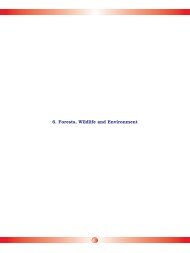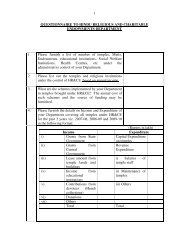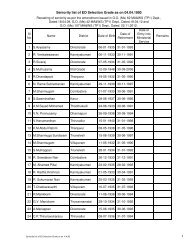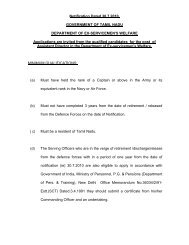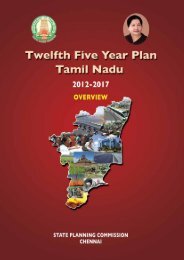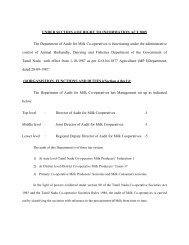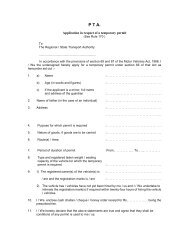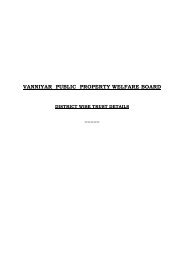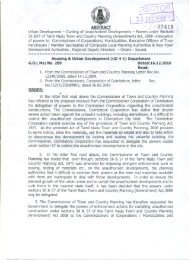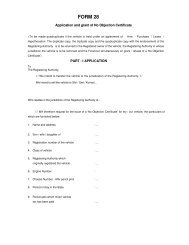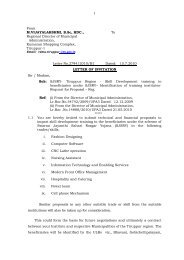Miscellaneous - Tamil Nadu Government
Miscellaneous - Tamil Nadu Government
Miscellaneous - Tamil Nadu Government
Create successful ePaper yourself
Turn your PDF publications into a flip-book with our unique Google optimized e-Paper software.
21.1. Secretariat Economic ServicesPlanning and applied evaluation is the key toeconomic development.- State Planning Commission21.1.1. IntroductionThe Secretariat Economic Services sector covers the planning, monitoringand evaluation services provided by the State Planning Commission (SPC)and the Department of Evaluation and Applied Research (DEAR) towards bettergovernance of the State. The Planning and Development Department effectivelyanchors this pivotal role in the State.21.1.2. Planning ServicesThe <strong>Tamil</strong> <strong>Nadu</strong> State Planning Commission is the nodal agency forplanning in the State. It was constituted on 25 th May 1971 and functionsunder the Chairmanship of the Hon’ble Chief Minister. It functions as anadvisory body and recommends strategies and programs to the <strong>Government</strong>on various matters pertaining to the development aspects of the State. Afterthe Assembly Elections held in 2006, the State Planning Commission wasreconstituted on 19.5.2006 under the chairmanship of Hon’ble Chief Ministerwith Prof. M. Naganathan as Vice Chairman, Dr. R. Srinivasan as Full TimeMember, Thiru Lakshmikanthan Bharathi, Prof. G. Chidambaram,Dr.P.Jagadesan, Thiru Thamizharuvi Manian, Dr. (Tmt.) Sunithi Soloman,Thiru Karumuttu T. Kannan as Part Time Members. The Secretary to<strong>Government</strong>, Finance Department and the Secretary to <strong>Government</strong>, Planning,Development & Special Initiatives Department are ex-officio Members. During2006, Tmt. Smita Nagaraj, I.A.S. was the Member Secretary, State PlanningCommission. From 2007, Tmt. Girija Vaidyanathan, I.A.S. has assumedcharges as the Member Secretary, State Planning Commission. The StatePlanning Commission presented the Approach Paper to the Eleventh FiveYear Plan in November 2006. For the first time, Regional Consultations wereheld in districts and views are elicited from the Members of Parliament,Members of Legislative Assembly, representatives of Local Bodies, NGOs,experts and academicians. The Draft Eleventh Five Year Plan document waspresented to the Hon’ble Chief Minister, Chairman of the State Planning829
Commission on 8 th December 2007. The outlay recommended for the EleventhFive Year Plan period (2007-2012) was Rs.85,344 crore. The main functionsand responsibilities of the commission are:(i)(ii)(iii)(iv)(v)(vi)to advise the <strong>Government</strong> on the priorities of the Eleventh Five YearPlan (EFYP) and Annual Plan.to prepare and send the draft Eleventh Five Year Plan and AnnualPlan to the <strong>Government</strong> for approval and send the same to theUnion Planning Commission (UPC).to review the progress of implementation of projects and programmesincluded in the Eleventh Five Year Plan on a periodical basis, withreference to achievement of targets/goals envisaged in the Five YearPlan.to undertake Mid-Term review of the Eleventh Five Year Plan andadvise the <strong>Government</strong> on appropriate modification/restructuringof the schemes.to undertake evaluation of major plan schemes through theEvaluation and Applied Research Department and recommend tothe <strong>Government</strong> the measures necessary to restructure or improvethe schemes based on such evaluation.to advise the <strong>Government</strong> on the effective implementation ofDecentralised District Planning (DDP) with reference to existingguidelines and <strong>Government</strong> orders.Performance during the Tenth PlanDuring the Tenth Plan, an outlay of Rs.12.56 crore was provided forplanning purposes. However, a sum of Rs. 7.22 crore was allocated to theState Planning Commission. The Commission, during the Tenth Plan period,had prepared four Annual Plans for the years from 2003-04 to 2006-07. Itregularly appraised the <strong>Government</strong> about the economy of the State. Anamount of Rs. 6.83 crore was spent on strengthening the planning machineryand enhancing the skill levels of the planning personnel.830
In addition to the task of preparing the plans for the State, the Commissionhas also assumed the responsibility of preparing the Human DevelopmentReports for the State and districts under the UNDP – Union PlanningCommission, sponsored Project for “Strengthening State Plans for HumanDevelopment”. Under this project, the Human Development Research &Coordination (HDR & C) Unit, has been established in the State PlanningCommission for carrying out the activities relating to Human Development.During the Tenth Plan period, the State Planning Commission prepared thefirst <strong>Tamil</strong> <strong>Nadu</strong> Human Development Report, which was released in 2003. Asa part of the Project, the HDR&C unit has also undertaken several activitiesencompassing advocacy of human development concepts, training, engenderingState Plans for human development and strengthening state statisticalsystems. The unit has also undertaken the preparation of the District HumanDevelopment Reports for the five districts of Dindigul, Thiruvannamalai,Sivagangai, Cuddalore and Nagappattinam. These reports are in the final stageof completion.Considering the relevance of the activities of the <strong>Tamil</strong> <strong>Nadu</strong> State LandUse Board (TNSLUB) for land use planning, the Board has been transferred tothe State Planning Commission. The Board is now functioning under thechairmanship of the Vice-Chairman, State Planning Commission. Secretariesto <strong>Government</strong> and Heads of Departments concerned with land and water useare its members and the Member Secretary, State Planning Commission isthe co-chairman of the Board. During the Tenth plan period, 22 studies havebeen taken up under the aegis of TNSLUB. The Board is in the process ofsetting up National Resources Data Management System (NRDMS) using GIStechnology in Cuddalore, Nagapattinam and Theni Districts at a cost of Rs. 23lakh. The Board has also been receiving financial assistance from the<strong>Government</strong> of India for conducting studies/programmes on various aspectsof land use such as watershed management, scientific conservation andagricultural development under the ‘Macro Management Mode Approach’.Eleventh Five Year PlanThe ProcessInitiating the preparation of Eleventh Plan, an Approach Paper wasprepared and widely circulated for eliciting the views and suggestions fromthe public. The paper indicated the broad focus areas and strategies for the831
Eleventh Plan. Further, Regional Workshops were conducted in Trichy,Coimbatore, Madurai, Tirunelveli, Thiruvannamalai, Villupuram and Chennaifor receiving the suggestions from stakeholders in formulating the EleventhFive Year Plan. Apart from this, 14 Steering Committees and 38 WorkingGroups for various sectors of the economy have been constituted by the StatePlanning Commission to provide inputs for the preparation of the Plandocument in the form of sectoral reports.Objectives and StrategiesThe objective of the planning process is to achieve overall economicdevelopment with social justice. The objective can be achieved if the skills ofthe planning machinery are updated continuously and the system ismodernised with the latest infrastructure.Eleventh Plan ProposalsIn addition to the ongoing schemes of Rs. 0.58 crore, the following newschemes with a total outlay of Rs. 4.36 crore are proposed in the EleventhPlan.1. Preparation of Perspective PlansPlanning plays a crucial role in the development of the State. The Statehas prepared and implemented ten Five Year Plans. The Eleventh Five YearPlan is in the offing. In addition to the Annual Plans for the five years from2007-08 to 2011-12, it is proposed to prepare a Perspective Plan for importantdevelopment sectors during the Plan period. This will serve as a mid termreview of the plan schemes and help to identify the gaps in implementation aswell as resources for achieving the plan objectives. The sectoral perspectiveplans will be prepared using the expertise available in the Planning Commissionand the <strong>Government</strong> along with reputed institutions working in the areas.For this purpose, the possibility of instituting 'Chairs' in academic institutionsto pursue research in the areas of topical economic interest such as socialsecurity, poverty and financial management will also be explored.2. Capacity Building of Planning PersonnelIn order to enhance the capability of the planning personnel and also toenrich their knowledge regarding economics, budget, statistics, financialmanagement and other related subjects, it is proposed to conduct training832
and capacity building courses during the Eleventh Plan period. Specific focuswill be given to enhance statistical and analytical skills along with writing andcomputer skills. The training programmes will be conducted in collaborationwith expert institutions.3. Infrastructure DevelopmentIt is proposed to strengthen the State Planning Commission with adequateinfrastructure facilities so as to increase the efficiency and effectiveness of theplanning personnel.4. Data CentreThere is a need for a centralized data bank especially for data relating tothe social sector departments such as health and education. Even thoughsuch data are routinely collected by the line departments, they are not availableat one location for analysis by planners and academicians. It is proposed toset up such a data centre, which will be managed by the Planning Commissionin coordination with the District Planning Cells and district level units of theStatistics department.Totally, a sum of Rs. 4.94 crore is proposed in the Eleventh Plan forPlanning Services.21.1.3. Evaluation ServicesThe Department of Evaluation and Applied Research (DEAR), since itsinception in 1974, has been undertaking evaluation of the differentprogrammes and projects for better policy formulation and implementation.The major functions of the Department are:(i)(ii)(iii)(iv)Evaluating schemes, projects and programmes sponsored by theCentral/State <strong>Government</strong>s as and when required by <strong>Government</strong>.Carrying out ad hoc studies and surveys relating to specific areasand topics as assigned by the <strong>Government</strong> including Externally AidedProjects (EAP).Bringing out two annual publications, viz., (<strong>Tamil</strong> <strong>Nadu</strong> – EconomicAppraisal and An Economic-cum-Functional Classification of <strong>Tamil</strong><strong>Nadu</strong> <strong>Government</strong> budgetary Transactions) andCarrying out research on various topics.833
Several evaluation studies have been undertaken by the Departmentfrom time to time depending on the need of the different departments of the<strong>Government</strong>. The Department has also undertaken applied research such asrevenue forecasting exercises for various taxes as and when requested by theFinance and Planning Departments. It also provides valuable inputs to theState Planning Commission for efficient formulation of plans. Besides the twoannual publications referred to above, the department performs projectappraisal, research papers and analytical work.Performance during the Tenth Plan PeriodThe Department has completed 97 studies during the Tenth Plan period.The Tenth Plan provided an outlay of Rs. 32 lakh for evaluation services, whichwas placed under the control of DEAR. During the Tenth Plan period, anamount of Rs.113.16 lakh was spent on the evaluation services.Eleventh Five Year PlanObjectivesThe objectives of the department during the Eleventh Plan are:(i)(ii)(iii)(iv)to strictly adhere to the allotted time frame for completion ofevaluation studies;to strengthen the evaluation skills of the State EvaluationOrganisation;to improve infrastructure facilities with regard to InformationTechnology andto ensure timely release of the departmental publications.Eleventh Five Year Plani. Monitoring of Important ProgrammesAs monitoring is an essential tool for successful implementation of theproject, the area development programmes such as Drought Prone AreaProgramme (DPAP), Integrated Wasteland Development Programme (IWDP),Hill Area Development Programme (HADP) and Western Ghat DevelopmentProgramme (WGDP) etc., which are priortised by both the Central and State834
<strong>Government</strong>s may be monitored by this Department. Based on the quantumof workload, a dedicated team of staff may be sanctioned for this purpose. It isalso proposed that some specific areas covered under the HADP and WGDPprogrammes may be taken up for concurrent and ex-post evaluation on asectoral basis, which will help to optimize the benefits during the EleventhPlan period.ii. Social Audit of Some Basic ServicesSome of the major public services, funded by the Central <strong>Government</strong>,have been brought under Social Audit by an independent agency. This hasprovided useful feed back to the <strong>Government</strong> by providing valuable insightsas to what needs to be done to improve the quality of these services. Similarly,social audit of some basic services provided by the <strong>Government</strong> in <strong>Tamil</strong> <strong>Nadu</strong>such as Public Distribution System, Public Transport System, supply of drinkingwater, health and education services, etc. may be taken up by this Departmentto give proper feed back to the <strong>Government</strong>.iii. Research StudiesBesides conducting evaluation studies, this Department will also focusattention on research studies on current subjects such as E-governance, UrbanDevelopment and Migration.Eleventh Plan Proposals1. Hastening the Process of Data Collection and Monitoring throughPalmtop and Laptop ComputersThe officers in the cadre of Joint Director and Deputy Directors have tobe provided with laptops to review the progress of the field study and to enablethem to complete a substantial portion of the work related to the field study atthe field itself. Further, in order to quicken the data processing, the ResearchAssistants and Research Investigators may be provided with a Palm TopComputer. Hence, it is proposed to acquire laptop and palmtop computersduring the Eleventh Plan period in a phased manner. This would not onlyenhance the accuracy of data processing but would also facilitate faster dataanalysis and report writing.835
2. Modernisation of OfficeThe office space taken on rent from Khadi and Village Industries Board(KVIB) is essentially in the form of a hall, with limited provision for ventilationand light. In order to enhance productivity, the ambiance of the office wouldbe improved by going in for a modern planned office layout. This would entailreplacing the old and dilapidated worn-out furniture with ergonomicallydesigned modern furniture, providing cubicles and networking facility. Oldworn out equipment and vehicles will be taken up for replacement to improveoverall office efficiency.3. Strengthening of Electronic Data Processing (EDP) SystemIn view of the rapid obsolescence of computing systems and the need forhigher analytical capability, it is essential to upgrade the existing EDP systemby providing adequate computers and a server. This will be taken up in aphased manner over the Eleventh Plan period.4. Capacity BuildingWith a view to enhancing the knowledge and capability of the staff membersof this Department, training on various aspects related to evaluation and projectformulation is proposed. Reputed institutions in various parts of India will beused to provide training on the latest techniques in the above areas.6. Publication of ManualsA Departmental Manual was published in 2003, covering the functionsof this Department, studies taken up, techniques adopted for evaluation, projectformulation and forecasting. This Manual will be revised to update and includelatest techniques on the above subjects which would be of great use not onlyto the research staff of this Department but also to other government officers.Further, periodical publication on technical matters will also be taken upto enlighten the staff members of this Department regarding the moderntechniques involved in research and evaluation.7. OutsourcingIn view of the acute shortage of trained staff and vacancies due to attrition,there is a constraint in taking up major studies such as Base Line surveys,cohort studies and studies involving large samples. In order to provide836
<strong>Government</strong> with reliable quick feed back, it may be useful to selectively go infor outsourcing of studies which will be commissioned under the supervisionand guidance of DEAR. This would be specially required for completion ofcomplex and time bound studies which are required by the <strong>Government</strong> forpolicy making purposes.The Eleventh Plan outlay for Evaluation Services is Rs. 2.65 crorecomprising Rs.1.60 crore for ongoing schemes and Rs.1.05 crore for newschemes.21.1.4. Monitoring and Secretariat ServicesA monitoring and coordination cell is functioning in the Planning andDevelopment department for monitoring important plan schemes, besidestechnical cells for HADP and WGDP. The department also entrusts studies ofdifferent topics of interest to DEAR. Further the department provides grantsto technical and management institutes.Technical Assistance for Economic Reforms ProjectThe World Bank based on an agreement with the <strong>Government</strong> of Indiacarries out a Country Procurement Assessment with a view to improvetransparency, efficiency, and accountability of the systems of procurements.<strong>Tamil</strong> <strong>Nadu</strong> was one of three States that were taken up for the detailed study.Activities of the Project are creation of Procurement Cell, drafts, circulate,finalise, publish a set of standard bid and contract documents, revise finance,public works and account codes in consonance with the Transparency Act,Training institutions and Training courses, etc. The Project commenced on1.10.2003 and expected to be completed on 31.12.2007. The project cost isRs. 5.60 crore and so far, upto 2006-07, Rs.3.38 crore have been spent. Theconsultants submitted reports on "Measurement of Works executed andPayment of Value of Works". This system has been introduced in Public WorksDepartment, Water Supply and Drainage Board, etc. as an experimental basis.The consultants for Standardization of Specification (Data Books) of PublicWorks Department, Preparation of Standard Bidding Documents, Review andUpdating of Standard Data and Specification for Water Supply and SewerageWorks and Roads and Bridge Works have submitted their reports and theyare under scrutiny. So far, 38 batches of 1253 officials have attended 2 Days/3 Days workshop on Procurement Procedures conducted by the Anna Instituteof Management.837
For the above activities, it is proposed to allocate an amount of Rs. 11.71crore for the Eleventh Plan period.Eleventh Plan OutlayThe Eleventh Plan outlay for the sector ‘Secretariat Economic Services’ isRs. 19.30 crore as shown below:Table 21.1.1838
21.2. Economic Advice and StatisticsEconomics and Statistics are the indicators ofthe growth path- State Planning Commission21.2.1. IntroductionRegular monitoring and prompt course corrections are essential toaccelerate the pace of economic development. This can be achieved only throughrendering appropriate economic advice to the government using timely,adequate and accurate statistics. The need for such statistics increasesconsiderably when the State is heading towards a decentralized planning setup. The existing statistical system in the State captures a wide variety of dataconcerning different sectors of the economy as well as the social sectors. TheDepartment of Economics and Statistics (DES) is engaged in a systematicdata gathering and dissemination effort in the State solely to address theofficial statistics requirements. Vast amount of data are being collected onAgriculture, Industry, Prices, Manpower, Employment, Housing and other socioeconomic aspects of the society through various surveys and studies. However,statistics relating to health, education, nutrition etc. are handled by concerneddepartments. The DES releases the processed information in the form of reportsand publications on key indicators. The department is also responsible forconducting various census such as economic census, agricultural census etc.In addition, studies on various topics of current interest taken up underNational Sample Survey help in bridging the data gap in various sectoralassessments of the State.The system of data collection in the State is reviewed by the StateStatistical Committee reconstituted under the chairmanship of the ViceChairman, State Planning Commission. The Committee oversees the collectionof administrative statistics and suggests improvement so that such statisticscan be effectively used for monitoring, planning and policy making.21.2.2. Performance during the Tenth PlanAn outlay of Rs.10 crore was earmarked for providing economic adviceduring the Tenth Plan period and the funds were placed under the disposal ofthe Department of Economics and Statistics. The major objectives envisaged839
during the plan period were to improve the existing data collection underimportant sectors of economy, to enhance the use of data by timely release ofvaluable publications and reports and to upgrade the technical skills of theofficial statisticians on the applications of statistical tools through suitabletraining and interaction with academia. Against this, an amount of Rs. 3.45crore could be utilized for meeting the objectives. During this period, significantefforts have been made to strengthen the state statistical system by upgradingthe infrastructure facilities so that data collection and processing can be timelyand effective.The economic advice provided will be of little use if the statistics used toprovide such advice cannot reflect the current reality. This is especially truewhen the statistics are compared temporally. The system therefore requires aconstant revision and updating of the reference year or the base year for anyseries of statistics. During the Tenth Plan period, this has successfully beencarried out in the case of Index of Industrial Production and estimates of StateIncome. The base year has been shifted from 1993-94 to 1999-2000. Further,a new series of estimates of the State Income have now been brought out from1999-2000 onwards.The Fifth Economic Census was conducted in <strong>Tamil</strong> <strong>Nadu</strong> during 2005with 100% Central assistance in order to fill the data gaps in the unorganizedsectors. This has helped the State to assess the developments inentrepreneurial activity in the rural and urban areas on a completeenumeration basis. The <strong>Government</strong> of India had allotted a sum of Rs. 588.76lakh for the conduct of this census. It is noteworthy to mention that <strong>Tamil</strong><strong>Nadu</strong> was the first State to complete this activity.21.2.3. Eleventh Five Year PlanObjectivesThe major objective of the sector is to facilitate the Department ofEconomics and Statistics to provide advice for governance using timely,adequate, and accurate statistics. This would be accomplished by840
Effecting improvements in the existing system of data collectionEnlarging the scope of the existing surveys to encompass the socialsectorModernising the system of compiling estimates of State and DistrictIncomeEnhancing the utility of the different indices of Agricultural andIndustrial Production and of PricesReleasing more up-to-date publications.Improving the electronic data processing system and quickening thetransmission of data/statistics.Motivating and building up the skills of the statistical personnel tomeet contemporary needs.Thrust AreasMicro level, decentralised planning has been recognised as a tool to reduceregional imbalances and to ensure effective public participation in the processof development. Hence, more authenticated and elaborate data at the district,block and village levels is required. It therefore becomes necessary that thescope and coverage of the state statistical system has to be broadened so as tofacilitate the collection and compilation of timely, adequate and accuratestatistics at the grass root level. Such a system should also enable not onlytimely release of statistics but also initiate a mechanism to update and maintainthe data base.The Crop Estimation Survey is the only scientific technique to estimatethe crop yields scientifically and objectively. Enlarging its scope and coverageto more crops would definitely bridge the data gaps existing at the disaggregatedlevel. Further, there is scope for refinement of the estimates of the State andDistrict Income which is still prepared following a “top-down” approach. FieldStudies can help to fine tune the estimation procedure taking the groundrealities into account.841
Capacity building is yet another thrust area, and it is a continuousprocess. The resources invested in the form of hardware and infrastructurewill not yield the desired result, unless the field personnel and data managersare competent in data collection and analysis. It is therefore necessary toimpart adequate training to the personnel involved in data collection andmanagement. A major defect creeping into the data system is the non-samplingerror; the sampling error can be controlled through sophisticated sampledesign. Non-sampling error however, can be controlled only through welltrained,motivated and dedicated statistical personnel. Further, it is essentialto strengthen the infrastructural facilities in terms of improving the facilitiesfor both the data collection and analysis using state-of-the-art electronicequipment.Eleventh Plan Outlays and SchemesThe Eleventh Plan proposes to realize the objective of facilitating providingadvice for governance through the Department of Economics and Statistics ata proposed outlay of Rs. 26.24 crore. This will be accomplished through severalschemes. While schemes to the tune of Rs. 0.50 crore are ongoing from theTenth Plan, new proposals for a cost of Rs. 2.50 crore are proposed under thePlan. The State share of Centrally Sponsored Schemes for generating Statelevel statistics is proposed at Rs. 3.77 crore. The sectoral outlay for providingadvice through statistics is thus proposed at Rs. 5.55 crore. Apart from this, asum of Rs. 19.47 crore is also posed under the World Bank funded IndiaStatistical Strengthening Project, which include a major scheme for providingIT-friendly accommodation for the DES offices as well as a proposal forestablishing the Institute of Applied and Official Statistics at Chennai.The details of ongoing and new schemes are as follows:Ongoing SchemeModernization of Computer SystemsUpgrading the equipment available for data storage, process anddissemination is a continuous process for the statistical system. It is thereforeproposed that the scheme of Modernization of Computer Systems for theDepartment of Economics and Statistics would be continued during theEleventh Plan period at a cost of Rs. 0.50 crore.842
New SchemesImproving Infrastructure facilities in the DES OfficesIt is proposed to improve the infrastructure facilities in the different officesof the Department of Economics and Statistics at the State and District levelso as to enhance the efficiencies of data transmission and dissemination. Thescheme which includes provision of computers, generators, fax machines andother necessary facilities will be implemented at a cost of Rs. 2.50 crore.IT-friendly accommodation for the DES OfficesThe quality of statistics largely depends on the atmosphere prevalent inthe workplace. Clean and modern accommodation with access to latestequipments for data processing and transmission is the first step to be takenfor improving the quality of statistics. At present, the headquarters of theDepartment of Economics and Statistics is situated in one of the wings of abuilding owned by the Public Works Department. The building is inadequateand cramped and not suitable for expanding the IT resources and the activitiesthat will be undertaken by the Department using the latest equipment. It istherefore proposed that a new IT friendly building with facilities such as stateof-the-artElectronic Data Processing room, computer facilities at the individual’sdesk etc., is to be provided to the departmental headquarters at a cost ofRs.7.70 crore.There are three Regional Offices at Chennai, Madurai and Salem and allof them suffer from inadequate space and are housed in private buildings.Hence, it is proposed that three of the Regional Offices and 19 District LevelOffices will be provided office buildings with space of 286.50 square metersper office as per the <strong>Government</strong> of <strong>Tamil</strong> <strong>Nadu</strong> norms. The cost per buildingwill be Rs.30 lakh totalling Rs. 6.60 crore. Hence, a sum of Rs.14.30 crore isproposed for the construction of buildings for the Eleventh Plan. This may bemet under the World Bank funded India Statistical Strengthening project.Institute of Applied and Official Statistics at ChennaiThere are many Universities offering degree/diploma courses in theoreticalstatistics. But an institutional set up in the field of Applied Statistics includingOfficial Statistics is missing. To overcome this important short coming and toprovide periodical training for 115 officers and 1579 staff working both at843
State and District levels in the Department of Economics and Statistics, andalso act as a learning hub for official statistics in South India, it is proposedthat an Institute of Applied and Official Statistics (IAOS) be established atChennai during the Eleventh Plan period in <strong>Tamil</strong> <strong>Nadu</strong>, with state-of-the-artinfrastructure and full time faculty at an estimated cost of Rs. 3.25 crore.Further, it is proposed to provide IT infrastructure including hardware andsoftware to the different DES offices at an estimated cost of Rs. 1.92 crore. Thefunding of this proposal will be met under the World Bank funded IndiaStatistical Strengthening project.Centrally Sponsored Schemes1. Timely Reporting of Area of Principal CropsThe objective of the scheme is to frame timely estimates of area of 9principal crops viz., Paddy, Bajra, Jowar, Ragi, Cotton, Groundnut, Sugarcane,Potato and Onion at the end of each season of the agricultural year. It alsoaims at building up of land-use statistics based on priority enumeration of asample of 20% villages. The scheme, being implemented since 1972-73 willbe continued with the proposed outlay of Rs. 2.50 crore, which is the 50%State share in the Eleventh Five Year Plan. The remaining 50% share issponsored by the <strong>Government</strong> of India.2. Improvement of Crop StatisticsThe objective of the scheme is to identify, through the joint efforts of theCentral and State authorities, the deficiencies in the system of collection ofcrop statistics in the State and to suggest remedial measures. The scheme isintended to provide the basis for determining the precise lines on whichimprovement in the crop estimation would require to be effected. This scheme,being implemented since 1974-75, will be continued in the Eleventh Planwith an outlay of Rs. 1.27 crore being the 50% State share and the outlay isshown under the Crop Husbandry sector. The other 50% is sponsored by the<strong>Government</strong> of India.3. Agricultural CensusThe Agricultural Census, which is quinquennial in nature, intends tocollect details of number and area of operational holdings, land utilization844
statistics, study of cropping pattern, crop-wise/ source-wise area irrigated,tenancy holdings etc. The Census is proposed to be completed at an outlay ofRs. 3.58 crore during the Eleventh Plan. The scheme is fully sponsored by the<strong>Government</strong> of India.4. Economic CensusThe Sixth Economic Census is expected to be conducted in <strong>Tamil</strong> <strong>Nadu</strong>during the Eleventh Plan period with 100% grant from the <strong>Government</strong> ofIndia. An outlay of Rs. 2.50 crore is proposed for this purpose.5. Crop Estimation Survey on Fruits, Vegetables and Minor CropsThe objective of the Crop Estimation Survey on Fruits, Vegetables andMinor Crops is to frame reliable estimates of average yield per hectare andproduction of important crops such as mango, banana, citrus fruits, guava,grapes, brinjal, lady's finger, tomato and pineapple both at the District andState levels. The scheme is being implemented since 1982-83. It is proposedto continue the scheme during the Eleventh Plan also at a proposed outlay ofRs. 2.02 crore. The scheme is fully sponsored by the <strong>Government</strong> of India.6. Nodal Centre for Manpower and EmploymentThe scheme aims to collect information on different categories ofspecialisation from all the Engineering Graduates/Diploma Holders in <strong>Tamil</strong><strong>Nadu</strong>. It also attempts to assess the demand and supply position for the presentand in the future years, and to analyse the job requirements, matching facilitiesfor engineering education in the context of planning for economic growth anddevelopment of the country. An outlay of Rs. 0.79 crore, which will be fullysponsored by the <strong>Government</strong> of India has been proposed for the EleventhPlan period.845
Table 21.2. 1Table 21.2. 2846
21.3. Information and PublicityInformation and publicity are the sign boardof the nation.- State Planning Commission21.3.1. OverviewThe State plays a vital role in disseminating information regarding variousprogrammes, schemes and activities of the government which have an impacton the life of the public. Public Relations is an allied two way persuasiveprocess used as an instrument of generating goodwill, cooperation andunderstanding between the government on one hand and the public on theother.Both these areas have undergone a sea change due to the growth ofsatellite communication and internet technology, which has helped to shrinkdistances and make information readily available. The use of modern media,both print and visual, has helped the government to publicize its messages inevery nook and corner of the state with clarity and effectiveness. No doubt,these efforts will play a major role in creating awareness among the public,encouraging public participation and bringing them closer to the government.The wide spectrum of activity of the Information and Public Relationsdepartment includes issue of press releases to the daily newspapers, radioand television channels, spreading information about development schemeswidely among the public through <strong>Tamil</strong> Arasu magazine, as well as newsbulletins of the <strong>Tamil</strong> <strong>Nadu</strong> Film Division, and conducting exhibitions toenable people to understand various programmes of the State. It also includesconstructing memorials and statues for great leaders and scholars andorganizing functions to propagate their ideas. The Film and Television Instituteof <strong>Tamil</strong> <strong>Nadu</strong> set up in 1960 and subsequently named as the MGR Film andTelevision Institute, functions under the department and offers three yeardiploma courses imparting training in Film and Television Technology with anintake capacity of 70 seats.21.3.2. Review of Tenth PlanThe vision of the State was to provide responsive, value added and timelyservice to the people and media by providing information and related services847
for better acceptance and understanding of public policies and programmesby the people.The objectives of the State during the Tenth Plan were (1) propagatingthe policies of the state (2) creating awareness, particularly among the ruralmasses about the programmes and welfare measures using mass media (3)disseminating information on policies and programmes of the State throughperiodical exhibitions (4) upgradation of equipments and infrastructure inthe Film Division on par with the private media and press institutions (5)linking up of all the District Public Relation Offices and Directorate by networking(6) improving the content and display of <strong>Government</strong> publicationsparticularly <strong>Tamil</strong> Arasu and (7) organising information database includingphotographs with facility for archiving and selective retrieval to improve thequality of information dissemination. The state also gave priority to constructionand maintenance of memorials to the memory of great leaders of national andlocal importance as well as renovating the old monuments and governmentbuildings and putting them to use to conduct cultural programmes and socialactivities.Financial Review and PerformanceThe Tenth Plan outlay proposed for the Information and Publicity Sectorwas Rs. 21.55 crore. The expenditure incurred was Rs 6.31 crore, the detailsof which are given in the Table below.Table 21.3. 1Information and PublicityMost of the activities carried out by the State during the Tenth Planrelated to the release of announcements, news, programmes and pressstatements to the media, organising press meets and photo coverage ofimportant programmes/ events and meetings. Setting up of memorials,producing news magazines, film and video documentaries, organizing848
exhibitions and multimedia campaigns and awards and subsidies for filmswere some of the other schemes implemented by the State in this period.In <strong>Tamil</strong> Arasu Press, the monthly magazine <strong>Tamil</strong> Arasu, specialpublications, pamphlets, government invitations, posters and brochures areprinted. The total number of subscriptions for <strong>Tamil</strong> Arasu magazine till April2007 was 66,000. As a technology upgradation initiative, the press wasmodernized at the cost of Rs.0.36 crore during the Tenth Plan period.The <strong>Tamil</strong> <strong>Nadu</strong> Film Division covers and records the important events,releases news magazines, produces documentaries and video short films onsubjects of public importance. Initiative has been taken to quicken the filmand video production by using modern technology. A sum of Rs.0.57 crorehad been spent for <strong>Tamil</strong> <strong>Nadu</strong> Film Division during the Tenth Plan period.In MGR Film and Television Institute, each team of final year studentsproduces a short film as a part of their project work. The State provides a sumof 50 lakh a year for production of these films as well as for sending thesefilms to the National and International Film festivals. This institute has beenmodernized during the Tenth Plan period. The expenditure incurred by theinstitute was Rs. 1.70 crore.During the Tenth Plan period, the field publicity units were strengthenedby purchasing 11 video publicity vans. The district offices were strengthenedby provision of computers, television sets and communication facilities. Aspart of administrative improvement of the department, an expenditure ofRs 1.99 crore was incurred for the construction of buildings and provision ofinfrastructure facilities.The State is maintaining 41 memorials, 4 Arangams, 5 commemorationpillars and one memorial park. Valluvar Kottam, Rajaji Hall, Perarignar AnnaMemorial, Dr. MGR Memorial, Kamarajar Memorial house, all in Chennai,and memorials in various districts have been strengthened during the planperiodWelfare schemes for journalists such as Journalists’ Family Benefit Fund,Journalists' Pension, Jounalists' Family Pension and Housing Scheme forJournalists have also been implemented. The Journalists’ Family BenefitFund scheme was introduced at the end of Tenth Plan. The financial assistance849
anging from Rs.0.50 lakh to Rs.2.00 lakh is given to various categories ofjournalists who die in harness. The expenditure is met from the Chief Minister’sPublic Relief Fund. Under the Journalists’ Pension scheme, Rs.4,000 permonth as pension is given to retired senior journalists in impoverishedcondition. A family pension scheme is also implemented for such journalistswith a sum of Rs.2,000 per month being paid as pension to the family of thedeceased journalists who had received the Journalists’ Pension.21.3.3. Eleventh Five Year PlanVisionThe State is committed to the promotion of better acceptance andunderstanding of its policies and programmes by the people. To achieve thisend, the government will provide value added and timely services to the mediaand the public. Cordial public relations will be used as the mode to disseminateinformation on government programmes to the public effectively and efficiently.ObjectivesThe objectives of the Information and Publicity sector for the EleventhFive Year Plan are (1) to propagate the policies and programmes of the<strong>Government</strong>, (2) to create awareness among the people particularly the ruralmasses about the welfare measures of the <strong>Government</strong>, (3) to effectively usemass media and electronic media, as well as periodical exhibitions andmultimedia programmes for dissemination of such information, (4) to constructand maintain memorials and conduct functions periodically to pay homageand respect to the memory of great leaders and personages of National andState importance.StrategiesTo achieve these objectives, the following strategies will be followed: (1) Itis proposed to modernise the existing facilities available in the departmentand allied institutions to improve their performance and ensure quick andeffective interaction with media and public, (2) The administration of the officeswill be streamlined through computerisation and modern communicationtechniques (3) It is also proposed to fix measurable goals and objectives forthe department. A suitable mechanism to evaluate performance of staff willbe devised, based on which awards for motivation will be given.850
Plan ProposalsTo achieve the objectives laid down, the following schemes are proposedfor the Eleventh Plan.Ongoing Schemes1. BuildingsConstruction and maintenance of memorials and mani mandapams inmemory of Great Leaders are being implemented through the Public WorksDepartment. It is proposed to earmark a sum of Rs.1.00 crore for theEleventh Five Year Plan for construction activities. Rajaji Hall, Valluvar Kottamand Kalaivanar Arangam will be renovated for improving not only theirappearance but also their facilities for conducting programmes for the public.New Schemes1. <strong>Tamil</strong> Arasu PressThe <strong>Tamil</strong> Arasu Press provides information to the people on importantschemes and activities of the <strong>Government</strong> and thereby serves as an importantmedia tool to reach the different strata of the society. With the objective ofmodernisation and upgradation of equipment so as to improve the displayand content of the publication during the Eleventh Five Year Plan period, aComputerised two colour sheet fed offset machine with accessories and othermodern machinery are proposed to be purchased for the <strong>Tamil</strong> Arasu Press.A sum of Rs.3.00 crore is proposed for purchase of these equipments duringthe Eleventh Five Year Plan period.2. <strong>Tamil</strong> <strong>Nadu</strong> Films DivisionThe <strong>Tamil</strong> <strong>Nadu</strong> Films Division is engaged in the production ofnewsreels, bulletins, documentary films, video documentaries and videocoverages regarding government schemes and topics of current interest. Apartfrom this, Video News Magazines are recorded and disseminated to all DistrictInformation and Public Relations Offices for Field Publicity. With the objectiveof modernisation of equipments, it is proposed to strengthen this division byprovision of E.Library and Media Asset Management System with accessoriesalong with supporting technical staff during the Eleventh Five Year Plan. Asum of Rs.1.00 crore is proposed for this purpose.851
3. MGR Film & TV InstituteThe MGR Film & TV Institute, run by the <strong>Government</strong> is one of the threeinstitutions in the country imparting training in Film and TelevisionTechnology. This institute conducts three year diploma courses such asDirection and Screen Play writing, Cinematography, Sound Recording andSound engineering, Film Processing and Film editing as well as techniques ofTelevision Film Production. In order to modernise this institute to function onpar with the best in the country, upgradation and purchase of Digital VideoCamera and other cinematographic equipment and accessories are proposedat a cost of Rs.3.50 crore during the plan period.4. Strengthening Press Release section, Reference section, Photo sections,Exhibition section, Directorate and District OfficesThe Press Release Section, the Reference section and the Photo sectionare integral supporting wings of this department. It is proposed to strengthenthese wings through computerisation and office modernisation so as toimprove their functioning efficiency. The State and district offices will also beprovided with computers and other equipment to improve their networkingabilities and make them more timely and effective. A sum of Rs. 2.10 crore isproposed in the Eleventh Five Year Plan for this strengthening.Eleventh Five Year Plan OutlayIt is proposed to allocate Rs. 10.60 crore for the Information and Publicitysector during the Eleventh Plan. The schemewise details are given in thefollowing table.852
Table 21.3. 2Stationery and PrintingImprovement and Modernisation of <strong>Government</strong> PressesThe <strong>Government</strong> presses play a major role in <strong>Government</strong> functioning byprinting and publishing important documents such as <strong>Government</strong> gazettes,budget documents, reports of various committees, works related to LegislativeAssembly and secret and special reports to the <strong>Government</strong>. The <strong>Government</strong>presses are being modernized in line with the latest development in the fieldof printing technology in a phased manner. A sum of Rs.0.50 crore is proposedfor improvement and modernization of <strong>Government</strong> presses during the EleventhPlan period.Eleventh Five Year Plan OutlayA total outlay of Rs.0.50 crore is proposed for Stationery and Printingsector during the Eleventh Five Year Plan as in the following table.Table 21.3. 3Eleventh Five Year Plan Outlay853
21.4.1. Introduction21.4. Special Area ProgrammesÏUòdY« thŒªj kiyÍ« tUòdY«tšyuQ« eh£o‰F cW¥ò- FwŸ 737Waters up and down, hills and streamsWith strong forts as limbs country beams.- Thirukkural 737Land is the most critical input for agriculture. The demand for landincreases due to economic development but availability of land remainsconstant. Further, the quality of land is also getting degraded due to manyfactors. There are some areas in the State that require special attention tocontrol soil erosion and land degradation to restore ecology and environmentand to maintain the ecological balance and preserve the bio-diversity. Thespecial areas are:Hill Area - entire The Nilgiris districtWestern Ghats– 8 districts of <strong>Tamil</strong>naduEastern GhatsCoastal areaThe Eastern Ghats covering 16 districts of <strong>Tamil</strong>nadu and the coastalarea along the coastline of 1000 k.m represent two other special areas of theState. It is necessary to adopt a strategy for development of these specialareas, keeping in view the unique features and problems. There is a need toformulate area programmes for the socio- economic development, and forconservation, protection and preservation of these areas. The need to conservethe natural resources and their environment to prevent further damage to theeco-system has been recognized by the <strong>Government</strong>.21.4.2. Hill Area Development ProgrammeThe Hill Area Development Programme is in operation in <strong>Tamil</strong> <strong>Nadu</strong>from the inception of the Fifth Five YearPlan (1975-780) with 100% financial854
assistance (90% Grant and 10% Loan) fromthe <strong>Government</strong> of India with a view tosupplement the efforts of the State<strong>Government</strong> in preservation, protection andenrichment of bio-diversity of the Nilgirisdistrict. The main objectives of theprogramme are eco-preservation, ecorestorationand eco-development besidestaking care of the socio-economicdevelopmental needs of the people of thedistrict. The implementation strategy is nowSaplings raised in the Nurserygeared to the integrated watershedapproach, whereby all the sectors focus in selected priority watershed toenable optimization of resources and recharge of the water tables.The Nilgiris District, which forms an integral part of the Western Ghatswith an area of 2549 Sq. Kms. is located at the junction of the Eastern andWestern Ghats and has an average elevation of 2000 Mts. above the Mean SeaLevel. The highest peak is Doddabetta (2640 Mts. above MSL). The totalgeographical area is 2.54 lakh hectares and the area coming under forest is1.42 lakh Ha. (56.03%), while the area coming under cultivation is 78800 Ha.The non-food crops are cultivated in nearly 65% of the area, while the remainingarea are used for food crop cultivation. Tea and coffee are major non-foodCrops grown and tea is grown in over 50% of the total area.The Hill Area Development Programme is being implemented in theNilgiris District, which consists of four blocks, 11 Town Panchayats, 4Municipalities and one cantonment. Under this programme, till the year1995-96 only Forest, Soil Conservation and Horticulture were identified asthe core sectors. But from 1996-97 onwards, emphasis has also been laid onsome other important sectors namely Welfare of vulnerable social groups,Human Resources Development, Development of Local Bodies, Medical &Public Health, Animal Husbandry & Dairy Development, Roads, Tourism,Remote Sensing etc., and funds have been provided for development of thesesectors also.855
The specific objectives of the HADP programme are given below:To develop the ecology and environment, through eco-restoration,eco-preservation and eco-development.To stimulate socio-economic growth and development of infrastructurein the district.To involve the people in meeting their basic needs through improvedmanagement of their land and water resources.To give adequate and safe drinking water by development ofgravitational sources of water.To improve the health facilities including infrastructure facilities inprimary health institutions.To evolve a proper land use pattern keeping the socio-economic andecological parameters in view.To develop the horticulture and plantation crops.To improve livestock and cattle in order to increase the income ofrural households.To find appropriate technology and scientific inputs, which wouldsuit local conditions and harness local resources.Performance during Tenth Five Year PlanThe Union Planning Commission, <strong>Government</strong> of India has released asum of Rs.123.90 crore for the schemes implemented under HADP in theNilgiris district during the Tenth Five Year Plan.The major portion of the allotment under HADP has been earmarked forthe three core sectors, namely soil conservation, horticulture, forestry roadsetc. The emphasis has shifted gradually to watershed-based development withthe aim of attaining a sustainable development of the area from the year2002-03 and 60% of the total fund being earmarked for the priority watersheds.856
Table 21.4. 1The Nilgiris district has been delineated into 75 macro watersheds and10 macro watersheds have been saturated so far. During the Tenth Planperiod, various soil conservation measures have been taken up to the extentof 1780 ha. Stream training works for a length of 5174 mts. and 337 lakhworth of retaining walls were taken up in the district. Under Forest sector,4681 ha., forest area have been maintained and 1511 ha., new forest areahave also been generated. Other developmental activities such as provision ofdrinking water, construction of group houses, schools, primary health centres,and veterinary centres have also been taken up. Further NGOs, local farmersassociations and local people have been involved in the implementation ofschemes under HADP.857
Assets created under HADPNew HADP boat house at OotyGenepool Garden at <strong>Nadu</strong>gani, GudalurLow cost houses to SC/ST (1616 Nos.)Additional class rooms in the <strong>Government</strong> High/Higher Secondaryschools (11 Nos.).Primary Health Centre buildings (2 Nos.).Health Sub-Centre buildings (13 Nos.).New ward to Taluk Head Quarters Hospital (1 No.).Milch animals to farmers (100 Nos.).Building for casualty, ICU to Govt. Head Quarters Hospital at Udhagai( 1No).HADP Training Centre at Udhagai.Fruit preservation/demonstration unit for giving training to SHGs/farmers/Public.Automated Post-harvest handling Unit for washing/sorting of freshvegetables.Approach and Strategy for the Eleventh Five Year PlanThe Nilgiris district has major rivers like Bhavani and Moyar, which arethe tributaries of Cauveri and Pandiar. Of the 75 macro watersheds intowhich the district has been delineated, 14 macro watersheds (comprising of101 micro watersheds) will be taken as priority watersheds during the EleventhFive Year Plan period. The Watershed Association (registered under theSocieties Act) for each macro watershed will be the General Body comprisingall members of the watershed community who agree to participate in thewatershed development project. Local level people institutions such asWatershed Association, Watershed Committee and user groups have beenformed and the societies registered for day-to-day management and distributionof benefits. The working capital will be created through revenue generation858
and people's contribution for repair and maintenance of the works. This willcreate self-sustaining local institutions to take over the activities afterwithdrawal of the project.The major activities proposed under soil conservation are bench terracingworks with vegetative barriers/ fodder species etc., renovation of existingterraces, water harvesting structures, construction of check dams, channelalignment works, landslide treatment works. Under forestry - shola afforestation/ maintenance works around the sholas, raising and supply of seedlings,construction of water harvesting structures, creating awareness have beenproposed. Under Horticulture, the activities proposed are coverage of areaunder tea Planting with multi-tier cropping and distribution of high yieldingvegetable seeds/ fruit seedlings/ agriculture implements. Under AnimalHusbandry, it has been proposed to provide certain infrastructure facilities toincrease the quality and quantity of the milk yield so as to improve the socioeconomicstandards of the people. Under human development, it has beenproposed to form/ improve the play grounds in schools, construction ofadditional class rooms, toilets to the schools and to provide water supply andother essential amenities.The activities of the core sectors have been integrated with those of theother line departments to stabilize the ecology besides involving the localpeople along with the NGOs, by adopting Integrated Watershed Approach. Inorder to involve the farmers and local people in Planning for their own needs,Participatory Rural Appraisal meetings are being conducted in which thewatershed committees take part to express their views and suggest correctivemeasures. The proposals thus finalized are included in the perspective Planbeing prepared for the period of five years. The Plan has been prepared insuch a way that the needs and wants of the people will be fulfilled. Regularmeetings are conducted with the sectoral officers, NGOs, CommunityOrganizations and Watershed Development Team to review the progress ofworks. Watershed coordinators are also involved in the monitoring of variousworks taken up in the watershed area.Proposed Outlay for the Eleventh Five Year PlanThe outlay proposed for HADP in the Eleventh Five Year Plan will beRs.177.5 crore, at the rate of Rs. 35.50 crore per year.859
Around 60% of the annual outlay under HADP is proposed to beearmarked for works on Integrated Watershed basis and the remaining 40%for other than Watershed works which include 15% for maintenance cost forHADP assets already created and 10% for establishment cost.21.4.3. Western Ghat Development Programme - (WGDP)The Western Ghats region in <strong>Tamil</strong> <strong>Nadu</strong> starts from Gudalur Taluk inthe Nilgirs and ends up at Agastheeswaran Taluk in Kanniyakumari district.Since the Nilgiris district is covered under HADP, it is excluded from theimplementation of WGDP. Western Ghats region therefore falls in eightdistricts, namely Coimbatore, Erode, Dindigul, Theni, Madurai, Virudhunagar,Tirunelveli and Kanniyakumari covering 33 taluks. The total area coveredunder WGDP is 2.6 m.ha., or 20% of the total area of <strong>Tamil</strong> <strong>Nadu</strong>.The salient features of WGDP areDevelopment with watershed as basic treatment unit.Focus on soil and moisture conservation measures and conservationof bio-diversity.Participatory approach through involvement of PRIs and NGOsThe Western Ghats Development Programme is being implemented from1975-76 onwards with 100 percent Central Assistance (90% Grant and 10%Loan). Though started as a beneficiary-oriented economic developmentprogramme, the emphasis gradually shifted towards socio-economic growth,development of infrastructure and promotion of ecology. Under WGDP, 70%of the resources have been earmarked for the sectors relating to these prioritiessuch as soil and water conservation, forestry, housing and other infrastructure.Performance during Tenth PlanUnder the WGDP, during the Tenth Plan period, Agriculture and Alliedactivities including soil and water conservation measures were taken up in135 watersheds at a cost of Rs.61 crore. Horticultural activities such asproduction and distribution of Planting materials and development of860
horticultural crops were undertaken. Under forestry, raising Plantations,maintenance of Plantations, soil and water conservation measures, gap fillinginfrastructure, housing and welfare of SC/ST were taken up. The other activitiestaken up under WGDP were animal husbandry, sericulture, fisheries, ruralroads, tourism, minor irrigation etc.Table 21.4. 2Approach and Strategy for the Eleventh Five Year PlanThe WGDP operates on the following principles:Maintenance of ecological balance essential for the life supportsystem;Preservation of genetic diversity;Restoration of ecological damage caused by human interaction; andCreation of awareness among the people and educating them on thefar- reaching implications of ecological degradation and securing theiractive participation for the eco-development schemes.861
The Western Ghats region is facing soil erosion and eco-degradationproblems. The WGDP therefore aims at development in a holistic manner withSpecial Area Programme watershed as the basic treatment unit foraugmentation and stabilization of production and productivity, minimizingecological degradation, reduction in regional disparity and opening up ofgreater opportunities for employment of rural poor. The broad objectives underWGDP are maintenance of environmental stability through forest preservation,conserving natural heritage by preserving the remaining natural forests,checking soil erosion and denudation of the catchment areas of rivers, lakes,reservoir in the interest of soil and water conservation, increasing thesustainability of the forest/ tree cover through afforestation and social forestryprogrammes, meeting the requirement of fuel, fodder, minor forest produceand small timbers of the rural and tribal population and creating a massivepeople's movement with the involvement of women for achieving theseobjectives. Activities proposed to be taken up under the programme includeproviding veterinary assistance and health coverage to livestock and poultry,taking up road improvement works, preparing environmental atlas with theassistance of GIS and remote sensing techniques to identify hot spots andaddressing pollution problems in the river systems like Bhavani, Vaigai andTamiraparani etc.Outlay for the Eleventh Five Year PlanWith a view to achieve the above objectives and to undertake the aboveactivities, the outlays for implementation of WGDP during the Eleventh Five-Year Plan period will be Rs. 85.20 crore at the rate of Rs. 17.04 crore per year.21.4.4. Eastern Ghat Development ProgrammeThe Eastern Ghats in <strong>Tamil</strong> <strong>Nadu</strong> are spread over in an area of about3.25 million ha in 16 districts - 3 districts in coastal eastern ghats, 9 districtsin central eastern ghats and 4 districts in southern eastern ghats. The majorhills in Eastern Ghats are: a) Javadhu hills (Vellore district), b)Pachaimalai(Trichy & Salem districts), c) Kollimalai, Servarayan and Bodamalai (Salemdistrict), d) Kalrayan hills (Salem and Villupuram district), Chitteris andMelagiris (Dharmapuri). The Eastern Ghats have rich sources of manganese,bauxite, graphite, lime stones, Gemstones, Magnetite etc., They are easilyaccessible for encroachment for human habitation and cultivation. Due to862
heavy pressure, the list of threatened species in this area is increasing day byday which requires immediate attention to restore the original ecosystem.The general problems and constraints encountered in Eastern Ghat areasare (a) soil erosion, poor fertility status of soil, and stream bank erosion insome rivers; (b) large scale deforestation; (c) degraded and gullied commonlands and grassing lands due to large scale exploitation, (d) lack of informationon farming and cropping systems; (e) lack of good water management systemand practices in the irrigated areas: (f) incidents of fire due to phases of burningduring process of shifting cultivation; (g) low economic status and fragmentationof land holdings; (h) periodic droughts and floods due to heavy run-off andsiltation of river beds; (i) uncontrolled mining activities; (j) declining groundwater table due to excessive use and withdrawal of ground water and lack ofwater harvesting / water conservation measures; and (k) inappropriate landuse system.The main objectives of the Eastern Ghats Development Programme arebiodiversity conservation, providing vegetal cover to the degraded and highlyeroded forest areas, improvement of water yield and ground water. Preventionof soil loss, skill development and generation of employment opportunities forthe local people/ tribals to improve their socio-economic status; and creationof eco-awareness are also priorities of the programme. Research of specificproblem related to area will also be taken up.The departments/ agencies involved are Agricultural Engineering,Horticulture, Highways and Rural works, Animal Husbandry, Agriculture,Sericulture, Public Health, Education, Tribal Welfare Departments, DRDA,TEDA, Khadi and Village Industries etc.The important strategies for the implementation of the programme areWatershed based development andPeople's participation to meet their basic needs in consonance withtheir ecological and livelihood security.Performance during the Tenth Five Year PlanThe Eastern Ghats Development Programme was not included in theearlier Plan schemes. During the Tenth Plan period, an amount of Rs. 1 crore863
was sanctioned during 2005-06 for the implementation of Eastern GhatsDevelopment Programme. Against which an amount of Rs. 0.96 crore wasspent on various activities by different departments.Table 21.4. 3Outlay for the Eleventh Five Year PlanDuring the Eleventh Five Year Plan, an amount of Rs. 5.00 crore isproposed for the Eastern Ghats Development Programme. This amount isproposed to be invested in a pilot project area, so that this pilot project areacan be developed as a model. This will lead to further developmental activitiesin other parts of the Eastern Ghats area. A part of this fund will also be usedfor preparing a detailed project report on this programme.21.4.5. Coastal Area Development ProgrammeCoastal area may be regarded as the land immediately behind the shore.The coastline of <strong>Tamil</strong> <strong>Nadu</strong> extends over 1000 kms. in length commencingfrom Pulicat lake to Kanniyakumari with about 80-96 km width with an averageelevation of 77m above the sea level. The geographical area of the 11 coastaldistricts accounts for nearly one-third of the total geographical area of thestate. The coastal area is characterised by the rich natural resources andintense human activities.The coastal area in <strong>Tamil</strong> <strong>Nadu</strong> is susceptible to cyclones periodicallywhich cause damage to life and property. The coastal area supports several864
important economic activities such as fisheries, ports, industries and tourism.The total population in the coastal towns of <strong>Tamil</strong> <strong>Nadu</strong> is about 27% of thetotal urban population in the state. Most ecologically critical and threatenedareas in the coastal areas are coastal wet lands especially lagoons and estuariesand their mangrove swamps. The coastal areas provide food and shelter forwaterfowls, fishes, crustaceans, molluscs including some of the world's lucrativefisheries. Mangroves and coral reef system are important for protectingshorelines and coastal lines against erosion. Thus coastal areas play aprominent role in the human life.The coastal areas face many problems but have high potential for economicdevelopment. The problems are sea water intrusion which affects drinkingwater in coastal areas, swamps, which occupies large area and is unproductivecreating environmental problems, sea erosion due to monsoon wind, wavesetc. The potentials are sandy tracts that could be used for agriculturalproduction by growing vegetables and fruit crops by using drip irrigation. Theexcess rain water and flood water could be used by the farmers to grow fish,which will bring more income to them. Further, there is a great scope forpromotion of tourism in the entire costal belt.The programme of the ICADP will be implemented by the State<strong>Government</strong> Departments of Agricultural Engineering, Environment, Fisheries,Forest, PWD and Tourism along with the participation of Industries, Ports,NGO's and research institutions operating in the coastal areas.The Objectives of Integrated Coastal Area Development Programme areTo protect heritage and cultural sites and fragile ecosystem.Promote natural resources by conservation-based development inorder to achieve continuous improvements in the quality of humanlife.Foster sustainable human development through a job-led economicgrowth strategy.Develop integrated area development projects covering capturefisheries, brackish water, aquaculture and coastal forestry and agroforestry.865
Establish cyclone and disaster mitigation measures andinfrastructure.Develop monitoring mechanisms for ensuring the health of coastalecosystem and conservation of coastal biological diversity.Performance during the Tenth PlanDuring the Tenth Plan period, an amount of Rs.1.00 crore was sanctionedunder part II scheme of 2005-06 for the implementation of Integrated CoastalArea Development. The department wise financial achievement is listed belowin Table 21.4. 4.Table 21.4. 4cOutlay for the Eleventh PlanDuring the Eleventh Five Year Plan, an amount of Rs.5.00 crore is proposedfor the Integrated Coastal Area Development Programme. During the EleventhFive Year Plan, the works under Integrated Coastal Area DevelopmentProgramme shall continue mainly in Forest department, Agriculturedepartment and other Allied departments.866



